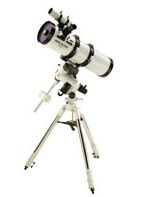This is a pretty cool photo from an image gallery at the website of a well-known telescope maker called Meade Instruments.
This is a deep sky object called the Dumbbell Nebula, also known as Messier 27. Below the photo is the description of how the amateur astronomer created the photo:
M27 by John Graham. LRGB (L:80x30sec, RGB 30x30sec each, high gain) taken with a Meade DSI Pro at the prime focus of an LXD75 SN6. The source images were saved as FITS, aligned in ASIP, combined in Drizzle, LRGB assembled in Photoshop. The color balance was set using an RGB response ratio of 2:1:1.2.
Now the photo is beautiful but a lot of that description looks like gobbledygook. I’m going to quickly review what much of that description means because I think it’s interesting that such a beautiful picture involves so much, to put it bluntly, grunt work.
 Meade LXD75 SN6 & DSI Pro. First of all, one very cool thing about this picture is that is was taken with a very simple telescope, like this one. This telescope is small enough to be easily carried in and out of a house, and the telescope/camera combination only costs about a thousand dollars. Both are Meade products.
Meade LXD75 SN6 & DSI Pro. First of all, one very cool thing about this picture is that is was taken with a very simple telescope, like this one. This telescope is small enough to be easily carried in and out of a house, and the telescope/camera combination only costs about a thousand dollars. Both are Meade products.LRGB (L:80x30sec, RGB 30x30sec each, high gain). The camera, the DSI Pro, is an electronic camera that connects to a computer. The letters “LRGB” stand for luminosity, red, green, blue. The camera is a black and white device, so to create a color image an astrophotographer takes multiple pictures and then combines them. Some photos are taken through filters—red and then green and then blue—and some are taken without filters—luminosity. For this photo the astrophotographer took 80 photos without filters, each photo 30 seconds long. Then he took 30 photos through a red filter, each photo 30 seconds long. And 30 photos through a green filter, each photo 30 seconds long. And finally 30 photos through a blue filter, each photo 30 seconds long. That means this one pretty photo is really a composite of 170 individual images. Although each photo was only exposed for 30 seconds, when you add them all up that comes to almost three hours of exposure time. Since it takes time to switch filters this one image required either a full night of picture taking or the individual images may have been taken over more than one night.
The source images were saved as FITS. FITS is just the name of an image format. The software that operates the camera controls stuff like that.
Aligned in ASIP. When you take many different pictures of the same object, inevitably there will be some differences in the orientation of the telescope. ASIP stands for “Autostar Imaging Processing” and is just the trade name of the software Meade includes when you buy one of their cameras. The software evaluates the content of multiple images and creates output where all the images line up properly.
Combined in Drizzle. “Drizzle” refers to a software procedure for image processing. Astronomers created Drizzle routines to process images from the Hubble Space Telescope, and the routines have been released and adapted by amateurs all over the world. Basically what Drizzle does is look at every image in a collection of images and creates statistical maps of the data, then evaluates the numbers to ‘decide’ which bits are genuine information and which bits are noise. The results of ‘cleaning up’ an image stack with Drizzle can be amazing. The modern theory is that taking many fast photos creates a higher quality final image than one long photo because each fast photo will include different errors and software can use statistics to make sense out of those differences.
Assembled in Photoshop. The color balance was set using an RGB response ratio of 2:1:1.2. Photoshop, of course, is Adobe’s insanely expensive but also insanely powerful image-processing program. Photoshop takes all the ‘cleaned up’ images and adds the colors—red, green, blue—based on the ratios chosen to create the most ‘natural’ looking image. There is some debate about what is natural for astronomical images. When you look at something like the Dumbbell Nebula in real life—I’ve seen it!—through all but the largest amateur telescopes it appears mostly as a white and gray blur. Colors are usually chosen to represent what an object might look like in the judgment of the astrophotographer if you could somehow transport yourself out into space and observe the deep sky object from just a few light years away.
*
So all that goes into creating one “simple” looking beautiful image. It’s a lot of work, and there are quite a few choices the astrophotographer makes. The same deep sky object can look very different depending on who takes the pictures and processes the images.
It’s interesting to compare the pleasure of looking at an image like this and the “real life” pleasure of looking at a deep sky object with a pair of binoculars or a small telescope. They’re really two different kinds of pleasures, two wildly different experiences. At some point in the future I’ll talk about this more, but for this post I just wanted to discuss this sequence, all this work, of creating a “simple” image.
. . . . . . . . . . . . . . . . . . . . . . . . . . . . . . . . . . . . . . . . . .
Saturn and Titan, And The Pleiades
Cosmic Fireflies
Cosmic Butterflies
Cosmic Swarms
Stars And Bugs


No comments:
Post a Comment